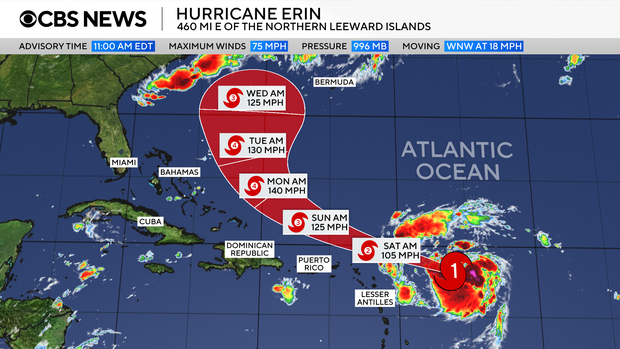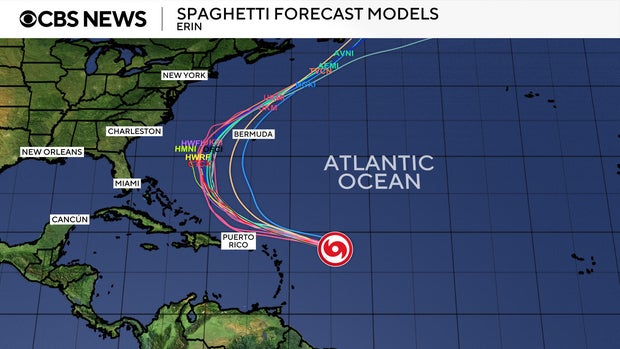Erin exploded right into a Class 5 hurricane on Saturday after quickly strengthening over the Atlantic Ocean, the Nationwide Hurricane Middle mentioned.
The Miami-based heart mentioned hurricane hunters discovered Erin had most sustained winds close to 160 mph and its outer bands had been impacting the northern Leeward Islands. A Class 5 hurricane is outlined as having most sustained winds of 157 mph or increased.
As of 5 p.m. Saturday, the hurricane was positioned about 135 miles northwest of Anguilla, shifting west at 15 mph. The storm’s heart was forecast to stay at sea, passing 145 miles north of Puerto Rico, in keeping with the Nationwide Climate Service.
Erin’s heart was forecast to maneuver simply north of the northern Leeward Islands, the Virgin Islands, and Puerto Rico by Sunday, and move to the east of the Turks and Caicos Islands and the southeastern Bahamas Sunday evening and Monday, the hurricane heart mentioned.
A satellite tv for pc picture of Hurricane Erin at 6:20 p.m. Japanese Time on Aug. 16, 2025.
NOAA
A “gradual weakening” was forecast to start Monday, the hurricane heart mentioned.
Tropical storm watches had been issued for St. Martin, St. Barts, St. Maarten and Turks and Caicos Islands. The hurricane heart warned that heavy rain in some areas may set off flash flooding, landslides and mudslides.
Erin, which grew from a tropical storm right into a hurricane on Friday, is the primary hurricane of the 2025 Atlantic season.
Forecasters have been urging folks within the Caribbean islands to observe Erin’s progress, warning of the potential for heavy rainfall and life-threatening surf and rip present circumstances.
Erin isn’t at the moment forecast to impression the US, however meteorologists proceed to observe it carefully.
Maps present Hurricane Erin’s forecast path
Forecasters anticipated Erin’s path to curve northward, with the hurricane passing close to the northern Leewards on Saturday. The northern Leewards stretch from the Virgin Islands to Guadeloupe and embrace St. Martin, St. Barts and different islands. Officers have issued tropical storm watches for a number of islands, alerting folks of the potential for winds ranging between 39 mph and 73 mph.
A map exhibits the projected path of Hurricane Erin as of 11 a.m. EDT, Aug. 15, 2025.
CBS Information
A “spaghetti map” of the forecast fashions exhibits the storm pivoting to the north, skirting the islands and remaining properly offshore of the U.S. East Coast.
A “spaghetti map” exhibits forecast fashions of the trail of Hurricane Erin, curving to the north because it strikes over the Atlantic, skirting the U.S.
CBS Information
A high-pressure system within the Atlantic was anticipated to steer Erin away from the Japanese Seaboard whereas a chilly entrance was additionally forecast to push the hurricane offshore, CBS Information Bay Space meteorologist Jessica Burch reported.
On the U.S. Virgin Islands, officers with the Nationwide Park Service introduced that websites on the island of St. Croix could be closed beginning late Friday afternoon till after the storm passes.
First hurricane of the Atlantic season
Erin fashioned as a tropical storm on Monday west of the island nation of Cabo Verde, a number of hundred miles off Africa’s western coast. It’s the fifth named storm of the 2025 Atlantic hurricane season, which began in June and runs by November.
Thus far this 12 months, Tropical Storm Chantal is the one one to have made landfall within the U.S., bringing lethal flooding to North Carolina in early July. In June, Barry made landfall as a tropical melancholy on Mexico’s jap coast.
Erin’s elevated energy comes because the Atlantic hurricane season approaches its peak in September. In keeping with the hurricane heart, a lot of the season’s exercise sometimes occurs between mid-August and mid-October. Within the jap Pacific Ocean, hurricane season begins on Could 15 with a peak in exercise sometimes seen in late August.
The U.S. Nationwide Oceanic and Atmospheric Administration, or NOAA, forecast an above-normal season for the Atlantic this 12 months, anticipating between 13 and 18 named storms.
Tropical storms have most sustained winds of not less than 39 mph. Forecasters with NOAA anticipated that between 5 and 9 of the storms this 12 months may change into hurricanes, which have sustained winds of not less than 74 mph. Hurricanes are rated on a scale based mostly on their wind speeds, starting from Class 1, the weakest, to Class 5, essentially the most extreme score.
NOAA forecasters predicted there could possibly be between two and 5 main hurricanes within the Atlantic this season.
Extra from CBS Information
Alex Sundby




